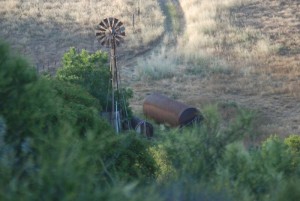 KB Home stumbles at Simi Valley Planning Commission meeting seeking project extension
KB Home stumbles at Simi Valley Planning Commission meeting seeking project extension
“Wild Bill” Bowling of the Radiation Rangers took offense when KB Home honcho Tom DiPrima denied that there were any tanks labeled for underground storage of flammable liquids with tubes leading into the windmill well at Runkle Canyon. After all, it was Bowling who photographed the windmill well in 2009.
“Who is this guy that comes in here and lies in the face of the commissioners?” Bowling says of the May 23 meeting of the Simi Valley Planning Commission. “For years we’ve seen KB Home mislead the community but this is the first time we’ve seen a KB representative and what does he do? He insults us and he insults the commissioners’ intelligence.”
Indeed, a review of the video of the meeting, where the Simi Valley Planning Commission was to vote on giving KB Home a 5 year extension to build 461 residences in Runkle Canyon, captures a number of instances where DiPrima, executive vice president of KB Home’s Southern California division representing Runkle Canyon LLC, makes statements that seem at odds with the truth.
SEE RUNKLE CANYON WINDMILL WELL WITH TANKS May 30, 2012
“So to your knowledge those tanks that we’ve seen the pictures of are not on that property?” asked planning commissioner Scott Santino, leveling his unblinking gaze at DiPrima.
“I’ve never seen them,” DiPrima replied. “In fact I was up at the windmill well and there’s no tank there. It’s very possible these could be another windmill well that could be adjacent to our property but not on our own property. But, again, DTSC was provided full access to the property.”
In fact, the tanks are still at the property as Bowling can attest. EnviroReporter.com can confirm the authenticity of photographs Bowling took May 30 of the windmill well tanks as well as a surveillance car parked high on a dirt road above the site several hundred yards away. The hike of over a dozen miles on sometimes weed-choked Ahmanson Ranch trails lasted ten arduous hours until 11pm that night, exhausting Bowling physically but not mentally.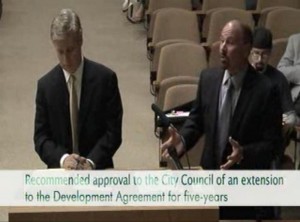
“When that guy from KB Home said he was up there the other day and there is no such tank, I was dumfounded,” says Bowling. “I could not believe my ears and was eager to watch it back on video. Once I did, I knew that somebody needed to prove that KB Home is lying to the city and in the past to who knows who. I decided after mapping my route on Google Earth, that I could legally take photos of the well from Ahmanson Ranch and, lo and behold, I see not only see that the tanks are still there, they’ve tipped over the big tank on its side, probably to tear off its metal ID tag, and they’ve got a guy sitting there watching over it.”
EnviroReporter.com can also verify that mountain bikers traveling downhill on that dirt road at dusk May 27 travelled past a light blue passenger van in the same spot overlooking the windmill well. The unmarked vehicle had a surveillance monitor on its steering wheel that showed a telescopic image of the windmill well, tanks and numerous 55-gallon drums first exposed by EnviroReporter.com last week in “Runkle Roulette.”
The driver took off after the bikers honking and yelling for them to stop and nearly clipped the second bicyclist roaring by going after the lead biker. After sliding to a halt on the sandy road cutting off the bicyclists with his vehicle, the man hopped out and demanded they turn around and leave.
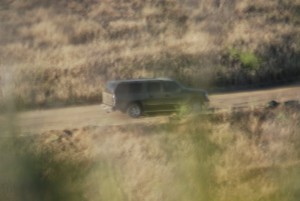 The agitated individual wore no identification nor said who he was or what he was doing driving so dangerously to stop a pair of mountain bikers rolling down an unmarked fire road used by hikers and bikers alike. He ultimately he relented and let the pair continue downhill but not before they got a good look at the windmill well and the tanks that DiPrima claimed weren’t there.
The agitated individual wore no identification nor said who he was or what he was doing driving so dangerously to stop a pair of mountain bikers rolling down an unmarked fire road used by hikers and bikers alike. He ultimately he relented and let the pair continue downhill but not before they got a good look at the windmill well and the tanks that DiPrima claimed weren’t there.
The distant windmill well was exactly as Bowling had photographed it in 2009 and 2011.
“How can these people be trusted?” Bowling asks. “If they say their property is clean, should we take the word of these people who deny toxic storage tanks are on their property yet hire private security to guard them?”
There is only one windmill well on Runkle Canyon according to hundreds of pages of Runkle Canyon’s Final Environmental Impact Report. It was visible in photographs that the Department of Toxic Substances Control has according to press official Jim Marxen. “The tank has shown up in our photos since 1990,” Marxen said in an email May 30, “and the tank and drums were still there last time one of our staff members was on the property in 2009.”
Marxen also confirmed that trichloroethylene (TCE) had been found in the well in 4 out of 42 samples even though there are no known plumes of TCE in the area. TCE is a rocket engine solvent, among other things, and was used heavily at Rocketdyne. The chemical is a carcinogen and volatile organic compound and has fouled Rocketdyne’s groundwater with over 530,000 gallons of the goo. Nevertheless, Marxen said that DTSC would not rescind its No Further Action (NFA) on the property.
Bowling says that’s hogwash. “This is a well for livestock to drink, taking water from the drinking water aquifer,” Bowling tells EnviroReporter.com. “Pouring chemicals into it is a crime because it is illegal dumping. This is also at the headwaters of a blue-line stream protected by the Clean Water Act – Las Virgenes Creek. Nothing else should be in the windmill well water other than water. That tank has been there for at least 22 years so its contaminants may have spread far and wide by now. DTSC should have tested those tanks and told KB Home to get rid of them and the drums before signing off on the place.”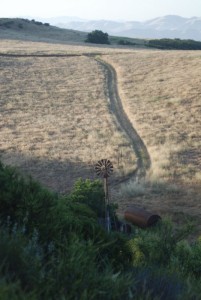
DiPrima took a novel approach to the problem of the industrial-sized toxic flammable liquid tank with hoses running from it into the Runkle Canyon windmill well – deny it’s there.
“I’ve never seen it,” DiPrima told another commissioner. ”We keep hearing these mysterious stories but DTSC has yet to find anything.”
DiPrima’s false insinuation that the residents were making up the tank story indicates the confidence the KB Home man, who didn’t once utter the name of his employer, had that the planning commissioners would side with the company over the residents. Yet with multiple sources of proof that these tanks are indeed still there, it seems that DiPrima may have prematurely counted on a favorable vote that night.
DiPrima and Runkle Canyon LLC’s attorney, Preston Brooks of Cox, Castle & Nicholson in Los Angeles, also made key “factual inaccuracies,” a phrase Brooks used to describe the comments of the public.
“Every issue that was raised in public comment was tested for,” Brooks asserted to the commissioners despite the presence of people from the community behind him in the audience who have demanded tests of the creek water since 2007, finally doing it themselves. Brooks claimed that “[A]ccess [was] allowed everywhere,”
The DTSC was indeed given access everywhere but as recently as the May 17, 2012 DTSC-hosted SSFL Open House, USEPA officials told Bowling and the Reverend John Southwick that KB Home lawyers were giving the federal agency the runaround over testing Offsite Well 21 (OS-21) — the windmill well.
When asked by a planning commissioner if he knew about KB Home not giving the USEPA access to OS-21, Brooks responded “Not that I’m aware of.”
When the Runkle Canyon extension item came up on the agenda, DiPrima and Brooks were preceded in their remarks to the Simi Valley Planning Commission by the planning staff. Planner Todd Militello led with the first ‘factual inaccuracy’ of the evening saying that in reviewing the information to make an environmental determination about the property, DTSC “reviewed all existing reports.”
Actually, the department did not include in its December 17, 2010 “No Further Action” (NFA) decision two key reports on Runkle Creek water heavy metals that the Radiation Rangers conducted May 18, 2007 which were followed by the city’s own testing July 2, 2007, guided to the same spots to sample by Southwick. Both tests showed high levels of arsenic, nickel and vanadium with the city’s sampling and results for the water even higher than the earlier Radiation Rangers’ tests.
Instead of looking at these crucial data on the heavy metals contamination in Runkle Creek, DTSC instead opted to take just two samples from the creek that they based their determination upon that the surface water was fine. But most curious was the DTSC finding that the two samples had no arsenic at all, since all surface water in the area has arsenic in it, most of it natural in places other than downhill of Area IV of the Santa Susana Field Laboratory.
Not only did DTSC not dismiss its two water samples as sampling and/or laboratory flubs, it ignored the Radiation Rangers and city’s two tests even after promising then-Mayor Paul Miller and Councilmember Glen Becerra to do so in a community meeting about Runkle Canyon in council chambers November 17, 2008.
“So just to clarify; you are looking at our report,” Becerra asked subsequently-sacked DTSC project manager for both the Runkle Canyon assessment and the cleanup of the entire Rocketdyne site, Norman E. Riley. “The citizen group that submitted their report; you’re looking at their information as well?”
“Absolutely, that’s correct, yes,” Riley replied, likely knowing full well that the department would not look at these tests worth thousands of dollars and, not incidentally, demanded by the Los Angeles Regional Water Quality Control Board as part of a ‘blue-line’ stream assessment of Runkle Creek. The developer at the time, Peter Kiesecker, blew off that requirement in the Final Environmental Impact Report for Runkle Canyon as documented in “Runkle Roulette.”
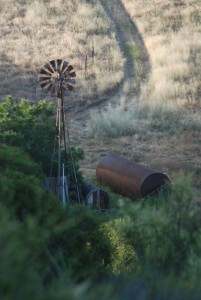 Despite understandable faith in DTSC, supposedly dedicated to sticking to the rule book, the city’s mayor, councilmember and public were deceived: DTSC deliberately dismissed this information which showed the harm an unsuspecting public and its pets could face from the creek water when using the property as open space in the future.
Despite understandable faith in DTSC, supposedly dedicated to sticking to the rule book, the city’s mayor, councilmember and public were deceived: DTSC deliberately dismissed this information which showed the harm an unsuspecting public and its pets could face from the creek water when using the property as open space in the future.
According to one former DTSC staff on an Internet forum January 9, 2011, just weeks after the NFA was announced, the decision to ignore the city and citizen’s reports wouldn’t have mattered much anyway – no amount of science mattered. “Norm Riley declared that Runkle Canyon could be released for a NFA well over a year ago, even before the additional testing was done,” posted Susan Callery who left DTSC for work at the Jet Propulsion Laboratory.
The No Further Action decision, which would obviate the need for fencing along Runkle Creek warning residents against coming in contact with it, may come back to haunt future residents of any eventual development in Runkle Canyon. Since 2005, EnviroReporter.com had heard reports, one documented photographically, of cattle and dogs dying after drinking the foul creek water.
Voluntary cleanup agreements like the one signed between DTSC and KB Home carry little weight with a community familiar with the repeated ‘bait and switch’ shenanigans of government agencies and developers. In this case, however, it is the Simi Valley Planning Commission which is having its ability to assess the extension of KB Home’s option to build undermined by staff which falsely stated that the environmental regulatory agency looking over the property based its decision on all the information available.
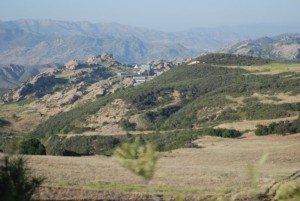 The 1,595 acre property borders the nuclear area of the Santa Susana Field Laboratory (SSFL), commonly known as Rocketdyne. The worst discharge of radiation from a meltdown in America occurred there at the Sodium Reactor Experiment in 1959 where hundreds of times more radiation was released from the uncontained reactor than at Three Mile Island in 1979 because the experimental reactor had no fortified structure housing the reactor like those seen at modern nuclear generating stations.
The 1,595 acre property borders the nuclear area of the Santa Susana Field Laboratory (SSFL), commonly known as Rocketdyne. The worst discharge of radiation from a meltdown in America occurred there at the Sodium Reactor Experiment in 1959 where hundreds of times more radiation was released from the uncontained reactor than at Three Mile Island in 1979 because the experimental reactor had no fortified structure housing the reactor like those seen at modern nuclear generating stations.
Since 2005, revelations about high strontium-90 contamination have dogged Runkle Canyon’s development plans. In 2007, the Radiation Rangers tested the surface water of Runkle Canyon Creek and found it loaded with high heavy metals. Two months later the city of Simi Valley did the same thing and the water results were even more polluted.
SEE RUNKLE CANYON WINDMILL WELL WITH TANKS May 30, 2012
KB Home bought Runkle Canyon from developer Peter Kiesecker’s GreenPark Runkle LLC in 2006 for $38 million and has sunk at least $4 million in taxes and fees into the place even as the fight over the environmental condition of the place intensified. Clearly, the company has counted on its cash and clout to carry the day.
Planning staff told the commissioners that the city could pocket $900,000 immediately if it signed off on the extension, $30,000 each for ‘in lieu’ fees for 30 low income seniors housing that KB Home would no longer be obliged to build. The company has already paid $5 million for a senior center and, in terms of giving to the community, would build upon approval a dedicated water tank and donate 1,090 acres of open space to the city for hikers, bikers, nature lovers and folks wanting to get a glimpse of Rocketdyne’s grossly contaminated Area IV through the fence.
Runkle Canyon’s hard-on-the-fence-line with Rocketdyne is a reality that KB Home would like to erase and what better way to do that than to talk it away.
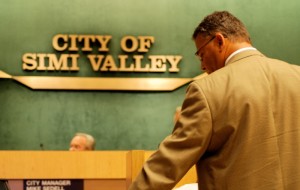 “It’s virtually impossible for water to drain from Area IV onto that part of the property,” DiPrima told the commissioners when Militello was finished, apparently forgetting the well-known fact that eleven acres drain from Area IV into Runkle Canyon.
“It’s virtually impossible for water to drain from Area IV onto that part of the property,” DiPrima told the commissioners when Militello was finished, apparently forgetting the well-known fact that eleven acres drain from Area IV into Runkle Canyon.
It was in this drainage that the USEPA recently found strontium-90 at 145 times background near the chain link fence border with Runkle Canyon which was found at even higher levels on Runkle property by the developer’s first labs testing the site in 1998 through 2000. USEPA considers anything three times background or above to be “significantly” above background while the California Highway Patrol uses that level as a tripwire for a hazardous materials situation with all the attendant protocols to protect patrolmen and women from harm.
Even those levels aren’t of concern according to the report dated the same day as the DTSC NFA on Runkle Canyon was issued called “Runkle Canyon soil sample evaluation and risk assessment DMA-TR-43” by Dade Moeller, the lab KB Home hired to plot out new testing spots for soil samples and then to analyze them.
The Dade Moeller report found that not only was Runkle Canyon strontium-90 contamination-free, it had just one tenth of the national average of the radionuclide in the soil. The report had a high 38% fail rate testing its samples. The lab included in its report a 2005 Dade Moeller report debunked by EnviroReporter.com January 19, 2006 despite it being discredited by the government. The report was subsequently referred to by the then-California Department of Health Services’ employee Robert Greger as “not considered useful” because of its high detection rate limits. Yet there it is being cited in a report DTSC signed off on.
Dade Moeller’s NFA-timed report also went on to identify the amount of radiation that could be found in Runkle Canyon soil that would satisfy the Preliminary Remediation Goal for open space users, 22.7 picocuries per gram which is 547 times background, an astonishingly high level of exposure to be considered safe.
Preston Brooks inferred that the Dade Moeller radiation report showed no elevated levels at all and that all the measurements were within background levels at the site. Brooks declared their “methodology more precise” with “more samples taken recently than in the past.”
Even by Dade Moeller’s controversial laboratory methods, 7 out of 36 samples were elevated above background with strontium-90 using the old lab technique versus the more modern and accurate method of radiation employed by the Foster Wheeler for the developer in 1999 and Harding ESE in 2000 also for GreenPark Runkle. These internationally known industry leaders in radiation detection took many more samples than did KB Home’s 36 soil samples on 1,595 acres, or one sample every 44 acres. The Foster Wheeler tests totaled 58 alone.
Brooks asserted this, ironically, after pronouncing “I think you’ve heard a lot of just factual inaccuracies we’d like to clear up.”
Factual inaccuracies aside, Brooks questioned even the logic of suspecting in the first place that a big real estate developer would want to develop on polluted land next to a huge outdoor lab that had multiple nuclear meltdowns and 30,000 rocket engine tests that left massive chemical contamination.
“I find it interesting that anyone would think that a developer, any developer, would want to proceed in an area that was known to be contaminated,” Brooks said to a slightly incredulous Santino. “Why would a developer do that? It doesn’t make sense.”
Why indeed. Why did KB Home build 587 houses at Southridge Hills in Arlington Texas on a Navy practice bombing range from World War II before thoroughly remediating it first? The Army Corps of Engineers found 187 practice bombs in total with 58 potentially live ones in the development and the adjacent property.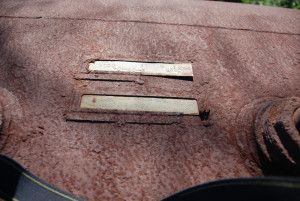
According to San Antonio-based Home Owners for Better Building, KB Home bought property that had a 1956 federal government clearance that said the land could be used for “above-surface use to which the land is suited.” In 1998, the US Army Corps of Engineers advised the developers to hire an “unexploded ordnance contractor if they had intentions of developing the site.” Neither happened and the explosive situation resulted in a class action lawsuit against KB Home.
It wouldn’t be too much of a stretch to ponder the motives for such actions, and actions like those witnessed at the May 23 Planning Commission meeting. The motive is money.
“These guys must take the commissioners for idiots which is a big mistake in Simi Valley,” said “The Good Reverend John” Southwick to EnviroReporter.com after the meeting. Southwick, like Bowling, is a Radiation Ranger. “They are lucky they weren’t under oath because I counted at least eight straight-out lies and several misrepresentations that could be considered lies. It was shameless and insulting to try to insinuate that we’re just a bunch of disgruntled residents. My opposition to this polluted place has cost me thousands in chemical tests the developer wouldn’t do and the notoriety of Runkle Canyon has hurt my property values. This nonsense must stop and the city of Simi Valley must protect its water supply and its citizens from this relentless developer more interested in dollar signs than building a safe development.”
Bowling is more sanguine but just as determined.
“You know, it would save the city a whole lot of grief and both it and KB Home a whole lot of money if they would see that the evidence is totally backed up by sound science from solid sources,” Bowling says. “It would be a tragedy if future residents and their kids get sick from a toxic stream or make the mistake of playing in radioactive dust. We’re here to make sure that doesn’t happen.”
Wednesday June 20 meeting with public comment & vote on Runkle Canyon five-year development extension:
Simi Valley Planning Commission
City Council Chambers
2929 Tapo Canyon Road
Simi Valley, CA 93063
Call to Order: 7:00 pm
SEE AHMANSON RANCH ON THE ROAD TO RUNKLE May 30, 2012
24 Years of Award-Winning SSFL/Rocketdyne Reporting
June 1998 – June 2022












In setting up a single purpose entity to own land at Runkle, and have houses built to sell to consumers, it is axiomatic that the land owner/seller entity be organized in a way to prevent people harmed by the entity’s activities being able to get a money judgment against the “deep pockets” controlling the development entity. That appears to have gone on at Runkle.
The latest twist in this sort of standard plan to avoid liability to homebuyers and their family members who become ill is the bankrupting of the development entity at the first sign of trouble after construction and home sales are complete. The goal of such a bankruptcy is to have the single purpose entity AND ITS OWNERS AND THEIR AFFILIATES be protected, by a Bankruptcy Court ORDER in a Chapter 11 Plan, which provides that the developer and its owners, employees and lawyers cannot be sued over “construction defects” or “failure to disclose” or for any other claim of any kind or nature. For projects with problems, a Chapter 11 after construction and sales are complete has become the world’s best safety blanket, because the home buyers and their families are forbidden by an enforceable Federal court order from suing for any reason.
As a result, KB Homes, as manager of the single purpose entity which owns Runkle and which wants to build on Runkle, can trudge forward, unafraid to sell homes to unsuspecting consumers even if the homebuyers might be exposed to radioactive elements or carcinogenic toxic chemicals at their new homes or from hiking above them.
As to potential City of Simi Valley liability for allowing construction of homes on land presenting risks of contamination, it’s simply not a problem. Many years ago a brave lady in Simi Valley named Peggy Finch led her neighbors in suing the city, among others, because their homes were built on top of a garbage dump which had been covered with a shallow layer of soil. After many years of litigation, the courts ruled the city had no liability to the homeowners even if the city made a grave error in allowing home construction over a garbage dump. I’ve often wondered if Rocketdyne used that dump, and what exactly those houses were built on, perhaps carcinogenic VOCs which would up-gas into the houses.
In the early 1980’s Peggy and her neighbors were early opponents of development at Runkle, and it’s as if she had an instinctive sense about the Rocketdyne-Runkle-Houses-Built-on–Dump connection. That brave woman, Peggy Finch, died years ago, of cancer, while living in her house “down gradient” from Runkle and Rocketdyne.
The California Department of Toxic Substances Control (DTSC) issued its “no further action” letter concerning Runkle in the waning days of the Schwarzenegger Administration, when DTSC’s Director knew he would not be appointed to head the agency in the Brown Administration. The DTSC’s current Director was the leader of San Francisco’s “environmental” department at the time that County approved development of a project called Hunter’s Point, without protecting that area’s residents from asbestos which would become airborne and put the local residents at risk of respiratory harm.
It’s very clear to me that neither the City of Simi Valley nor the California Department of Toxic Substances Control want to engage in protracted litigation over the safety of building housing at Runkle, to protect prospective homeowners. The property owner will trudge forward, the homes will be built, and our grandchildren, as law school graduates, will be left scratching their heads trying to figure out why California Governors, why California Directors of Toxic Substances Control and why City Councils of Simi Valley simply didn’t give a damn…even though they knew.
Strontiums 89 & 90 take up in living matter. Has the thought occurred that perhaps algae and bacteria in and around the Runkle tanks in question (also, in fact, the Chatsworth Reservoir, as a commentor mentioned previously) might just as well harbor radio strontiums and yttriums? Learn here:
http://dissensus-japan.blogspot.com/2012/06/easy-guide-on-biological-concentration.html
It has been known for a while now that DTSC refuses to answer questions regarding testing of plants and biota in and around Rocketdyne including offsite parcels impacted by contamination. Maybe CalEPA needs more staff biologists and less staff geologists when it comes to testing for radio particles. DTSC geologists term everything as ‘soil’; when, in fact, there exists an abundance of poisoned living matter — aka. “causative agents” — that get ignored by CalEPA’s incomplete science, ad infinitum.
It will be even more interesting to learn in coming days (ergo: years) just how CalEPA intends to RESTORE NATURE back to her original state.
I like the idea of a drone, with a video feed running images. It would provide some standoff room, and if it’s a hobbyist model, it would be legal to fly it. It needs loiter time and enough electrical power, though. Doable, I imagine.
“I did not have visual relations with that tank.”
How about asking Terry for help in obtaining a predator-type drone to monitor the situation and start surveilling?
—————
First they disperse (contaminants), dribble (information out very slowly), deny (opportunity to get it right), and deceive (misinformation, minimize, downplay, have lawyers lie for them).
—————
One can deny reality, but one cannot deny the consequences of a denied reality.
Unbelievable. This makes me think that one must assume the worst when it comes to protecting the health of the public. It would be great to have a Ustream feed running showing the well, the tanks, and the surveillance car during the next public hearing. Use a projector to show what’s going on while the interested parties say what they believe to be the truth. That would provide a humorous counterpoint to their comments.
These lying sacks would be funny if they weren’t poisoning the groundwater. At what point does the absurdity violate some sort of universal rule and just cave in upon itself?
Wow–caught with their dirty hand in cookie jar again. This must be the longest-running expose in history!
We all know that lawyers never lie. Never, ever. Perhaps its the condescending tone that irks those being lied to. “I’VE never seen them” is akin to No One Else Has Complained. Well, then, if YOU’VE never seen them, they must not exist! As Shakespeare once wrote, “First, kill all the lawyers.”
As for Simi officials, they seem eager to reject real science when the pay off is big enough. Like global warming, Koch brothers say they aren’t convinced that it is a problem. THEY aren’t convinced. Well then. Perhaps they could question the veracity of gravity.
I wonder, hypothetically, what would happen if a development were to be built on poisoned land (somewhere) and, somehow, don’t know how, word got out to potential buyers that those homes are rife with future illness and death. Wonder how much that would cost KB? Not everyone can be bought off. Or shot. Or run down. Did they think of that?
Bullies are the biggest cowards.